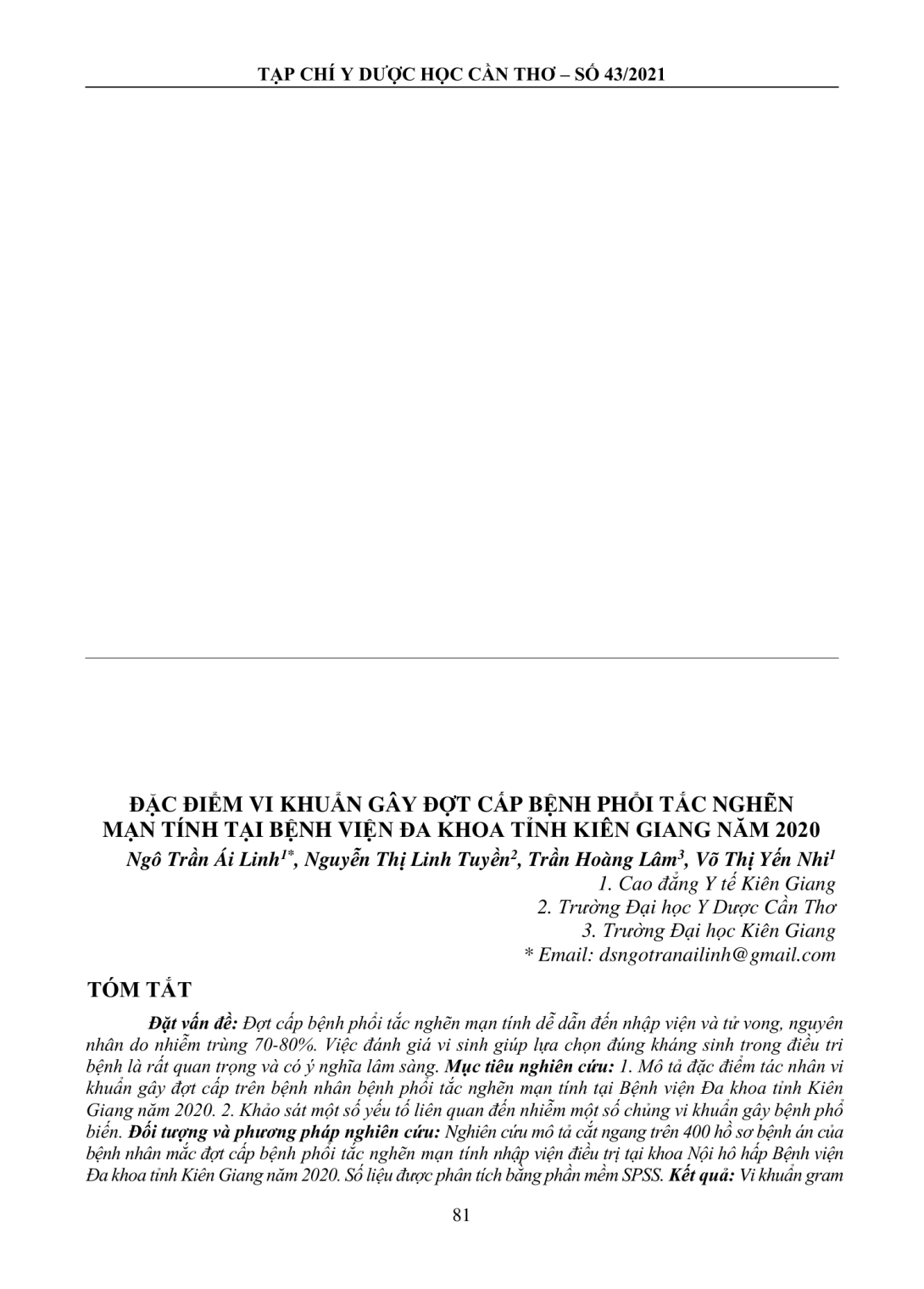
Đợt cấp bệnh phổi tắc nghẽn mạn tính dễ dẫn đến nhập viện và tử vong, nguyên nhân do nhiễm trùng 70-80%. Việc đánh giá vi sinh giúp lựa chọn đúng kháng sinh trong điều tri bệnh là rất quan trọng và có ý nghĩa lâm sàng. Mục tiêu nghiên cứu: 1. Mô tả đặc điểm tác nhân vi khuẩn gây đợt cấp trên bệnh nhân bệnh phổi tắc nghẽn mạn tính tại Bệnh viện Đa khoa tỉnh Kiên Giang năm 2020. 2. Khảo sát một số yếu tố liên quan đến nhiễm một số chủng vi khuẩn gây bệnh phổ biến. Đối tượng và phương pháp nghiên cứu: Nghiên cứu mô tả cắt ngang trên 400 hồ sơ bệnh án của bệnh nhân mắc đợt cấp bệnh phổi tắc nghẽn mạn tính nhập viện điều trị tại khoa Nội hô hấp Bệnh viện Đa khoa tỉnh Kiên Giang năm 2020. Số liệu được phân tích bằng phần mềm SPSS. Kết quả: Vi khuẩn gram âm 79,71%. Vi khuẩn thường gặp là Klebsiella ssp. (27,54%) kháng cao với cephalosporin; chủng Pseudomonas ssp. (20,29%) kháng cao với gentamycin và nhóm carbapenem; Acinetobacter baumannii (17,39%) kháng với ciprofloxacin và nhóm cephalosporin. Vi khuẩn gram dương có Streptococcus pneumonia (11,59%) kháng cao với nhóm betalactam.Một số yếu tố liên quan đến nguy cơ nhiễm khuẩn là bệnh nhân không hút thuốc sẽ giảm nguy cơ nhiễm chủng Klebsiella spp. (OR =0,02, p = 0,016 ). Nguy cơ nhiễm chủng Pseudomonas spp. giảm khi không mắc kèm bệnh tăng huyết áp (OR = 0,067, p = 0,040), đái tháo đường týp 2 (OR = 0,11, p = 0,011), bệnh lao phổi cũ (OR = 0,11, p = 0,003). Kết luận: Nhiễm khuẩn trong đợt cấp bệnh phổi tắc nghẽn mạn tính, vi khuẩn gram âm chiếm đa số. Vi khuẩn thường gặp là Klebsiella ssp., Pseudomonas ssp., Streptococcus ssp., Acinetobacter baumannii. Một số yếu tố liên quan đến nguy cơ nhiễm khuẩn như hút thuốc, mắc kèm bệnh lao phổi cũ, tăng huyết áp, đái tháo đường týp 2.
Exacerbations of chronic obstructive pulmonary disease (COPD) lead to hospitalization and death in COPD patients, with infectious causes accounting for 70-80%. Therefore, microbiological assessment to help choose the right antibiotic in the treatment of this disease is very important and has clinical significance. Objectives: 1. Describe the characteristics of pathogenic bacteria causing acute exacerbations of COPD at Kien Giang province General Hospital in 2020. 2. Investigate some related factors to infection with some common bacterial strains causing exacerbations of chronic obstructive pulmonary disease. Materials and methods: A crosssectional descriptive study was conducted on 400 medical records of COPD exacerbations were admitted to hospital for treatment at the Department of Respiratory Internal Medicine at Kien Giang General Hospital in 2020. Data processing method is using SPSS software. Results: COPD exacerbations caused by Gram-negative bacteria account for the majority (79.71%). Some common strains are Klebsiella ssp. (27.54%), Pseudomonas ssp. (20.29%) and Acinetobacter baumannii (17.39%). Klebsiella ssp. are highly resistant to cephalosporin, Pseudomonas ssp. are highly resistant to gentamycin and carbapenems; Acinetobacter baumannii are resistant to ciprofloxacin and cephalosporins. Gram-positive bacteria account for 20.29%. The most common strain is Streptococcus pneumonia (11.59%).They are highly resistant to betalactam. Some factors related to the risk of infection is not smoking reduces the risk of infection with Klebsiella spp. (OR = 0.02, p = 0.016). The risk of infection with Pseudomonas spp. is reduced in the absence of hypertension (OR = 0.067, p = 0.040), type 2 diabetes (OR = 0.11, p = 0.011), old pulmonary tuberculosis (OR = 0.11, p = 0.003). Conclusion: The majority of pathogenic bacteria are gram-negative. Common strains are Klebsiella ssp., Pseudomonas ssp., Streptococcus ssp., Acinetobacter baumannii. Some factors related to the risk of infection such as smoking, having old tuberculosis, having hypertension, having type 2 diabetes.
- Đăng nhập để gửi ý kiến
